| Oracle® Argus Affiliate User's Guide Release 6.0.1 E15947-02 |
|
|
PDF · Mobi · ePub |
| Oracle® Argus Affiliate User's Guide Release 6.0.1 E15947-02 |
|
|
PDF · Mobi · ePub |
This chapter includes the following sections:
This chapter describes the tasks that can be performed by the Central Users of Argus Affiliate. Unless you are an Enterprise Workflow Manager, you are limited to events you can access from the following dialog boxes:
Local Affiliate --> Worklist --> Pending Local Labeling
Local Affiliate --> Worklist --> Cases in Pending Central Actions
Local Affiliate --> Worklist --> Not Routed cases
If you are an Enterprise Workflow Manager, you can view all cases across multiple sites.
Note:
Central users must log on to Argus Safety Web in order to perform the activities that are related to local affiliates.In the Argus User Interface, select Worklist from the Local Affiliate Menu to access the different options available through this screen. The Worklist screen appears as shown:

The following table lists and describes each of the tabs on this screen.
| Field | Description |
|---|---|
| Pending Central Actions | Displays actions on local events that are pending at central |
| Not Routed | Displays local events that have not yet been routed to central |
| Cases Pending Local Labeling | Displays pending action items that have been assigned to the Local Affiliate Users. |
The following is an illustration of the Pending Central Actions tab.

The following table lists and describes the fields on the Pending Central Actions tab.
| Field | Description |
|---|---|
| Local Event Number | Displays the local event number. The link displayed in this field helps you in viewing event information. |
| Central Case Number | Displays the central case number. |
| Local Affiliate Number | Displays the name of the local affiliate. |
| Actions/Routing Comments | Displays any actions or routing comments for the case. |
| Print List | Prints the list displayed in the screen in a PDF. |
The following is an illustration of the Not Routed tab.

The following table lists and describes the fields on the Not Routed tab.
| Field | Description |
|---|---|
| Local Event Number | Displays the local event number. The link displayed in this field helps you in viewing event information. |
| Primary Suspect Product | Displays the name of the primary suspect product. |
| Primary Event | Displays the name of the primary event. |
| Country of Incidence | Displays the country where the adverse event occurred. |
| Local Affiliate Name | Displays the name of the local affiliate. |
| Print List | Prints the list displayed in the screen in a PDF. |
The following is an illustration of the Cases Pending Local Labeling tab.

The following table lists and describes the fields on the Cases Pending Local Labeling tab.
| Field | Description |
|---|---|
| Local Event Number | Displays the local event number. The link displayed in this field helps you in viewing event information. |
| Primary Suspect Product | Displays the name of the primary suspect product. |
| Central Case Number | Displays the case number with Central. |
| Primary Event | Displays the name of the primary event. |
| Country of Incidence | Displays the country where the adverse event occurred. |
| Local Affiliate Name | Displays the name of the local affiliate. |
When using workflow processing, be aware of the following:
The Central Case Number displays the workflow state in the following:
Worklist -- Pending Central Actions
Action Items From Local
Action Items From Central
Local Affiliate -- Initial Event Entry
Local Event Search
The Central Case Number displays the workflow state in the following:
The system displays the Country of Incidence of the Central case in the following:
Report Submissions (Submitted Reports Only dialog)
Report Submissions (Non-submit Reports dialog)
The field is scrollable to accommodate text that does not fit within the given column width.
The system updates the field labels on the Initial Event Entry dialog in the same manner as it updates the field label configured in the Initial Event Entry dialog in the Argus Console.
The Keyword enables you to search based on text entry rather than drop-down values.
The Print List displays the workflow state for the following:
Worklist -- Pending Central Actions
Action Items From Local
Action Items From Central
Local Affiliate -- Initial Event Entry
You can review incoming events from the Incoming Review page. The page has two tabs:
Initial
Follow-up
Select Local Affiliate => Incoming Review to open the Incoming Review page.
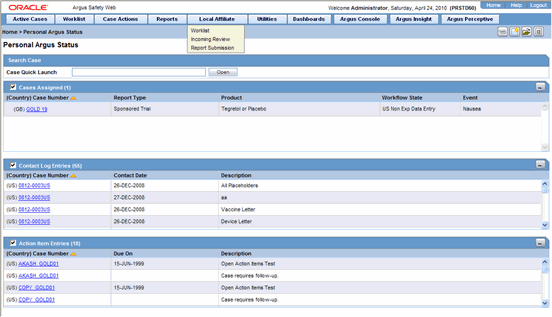
The system opens the Initial tab by default. On this tab you can review new incoming events.

The following table describes the fields on the Initial tab.
| Field | Description |
|---|---|
| # | Displays the serial number of each search result. |
| Action | Enables you to perform an action item. |
| Central Case Number | Displays the central case number of the event. |
| Local Tracking Number | Displays the local tracking number of incoming events. Click the link displaying the local tracking number to view the follow-up information. |
| Receipt Date | Displays the date when the incoming events was received. |
| Local Affiliate Name | Displays the name of the local affiliate. |
| Primary Suspect Product | Displays the name of the product that is most likely to have caused the adverse event. |
| Primary Event | Displays the name of the primary event. |
| Country of Incidence | Displays the name of the country where the adverse event occurred. |
| Patient Initials | Displays the initials of the patient. |
| Print List | Displays the list of follow-up events in a PDF. |
If you wish to review follow-up events or information click the Follow-up tab.
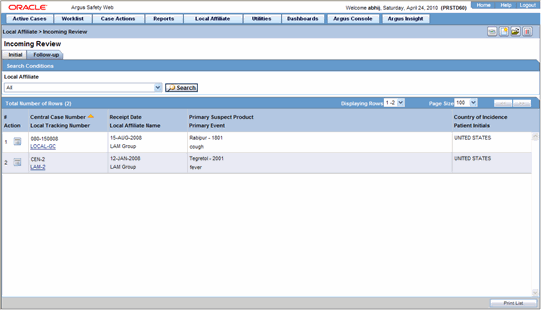
The following table lists and describes the fields on the Follow-up tab.
| Field | Description |
|---|---|
| # | Displays the serial number of each search result. |
| Action | Enables you to perform an action item. |
| Central Case Number | Displays the central case number of the event. |
| Local Tracking Number | Displays the local tracking number of incoming events. Click the link displaying the local tracking number to view the follow-up information. |
| Receipt Date | Displays the date when the incoming events was received. |
| Local Affiliate Name | Displays the name of the local affiliate. |
| Primary Suspect Product | Displays the name of the product that is most likely to have caused the adverse event. |
| Primary Event | Displays the name of the primary event. |
| Country of Incidence | Displays the name of the country where the adverse event occurred. |
| Patient Initials | Displays the initials of the patient. |
| Print List | Displays the list of follow-up events in a PDF. |
Under Local Affiliate, select the local affiliate whose events are to be reviewed.
Click Search. A list of matching search results is displayed.
The following table lists the columns that appear in search results:
| Initial Events | Follow-up |
|---|---|
| Local Tracking Number | Central Case Number |
| Receipt Date | Local Tracking Number |
| Local Affiliate Name | Receipt Date |
| Primary Suspect Product | Local Affiliate Name |
| Country of Incidence | Primary Suspect Product |
| Primary Event | Country of Incidence |
| Patient Initials | Primary Event |
| Patient Initials |
To view the incoming event or follow-up information, click the link associated with the Local Tracking Number.
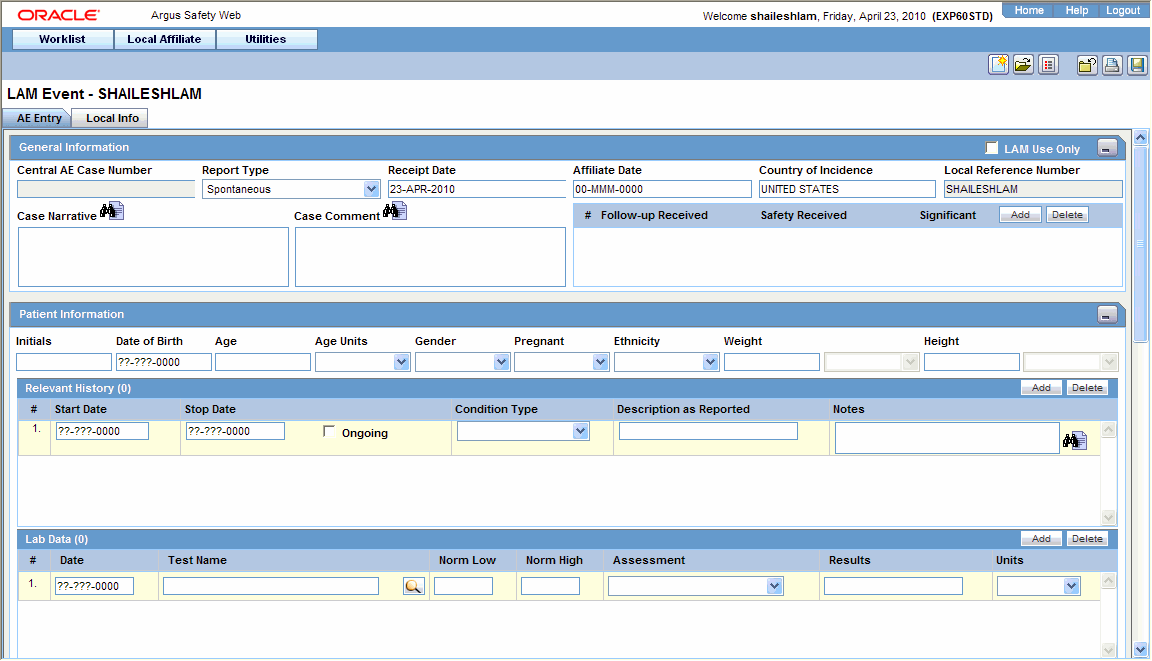
The event information viewed from here cannot be modified.
Tip:
You can accept follow-up information, and accept or reject local events, from the list of incoming events.When performing a duplicate search, be aware of the following:
You can perform a duplicate search for incoming follow-up cases.
When you click the Duplicate Search dialog, the system performs a duplicate search on the selected case.
The user can search a maximum of 1000 cases.
The system performs the duplicate search in the same way it performs the Central AE Bookin Dialog Dup search.
The system runs the duplicate search against cases in the Central AE database.
The Receipt Range Limits checkbox enables the user to restrict the search to the last 3 months. If the checkbox is unchecked, the system runs the search against all cases.
The system uses the Oracle Text profile settings for the duplicate search in Affiliate.
Review incoming events from Local Affiliates.
Click the icon associated with the required case and select Duplicate Search.
The Argus Safety Duplicate Search dialog opens.
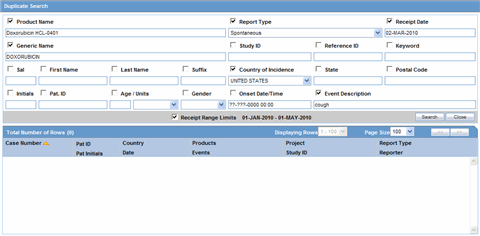
Select the check boxes associated with the items by which the duplicate search is to be executed. Clear the check boxes that are not to be considered for duplicate search.
Click Search. A list of search results matching the specified search criteria is displayed.
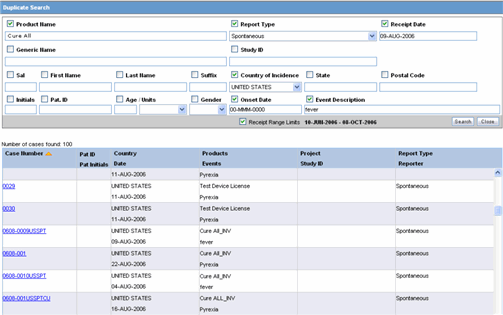
Inspect the search results to determine if the event is already associated with a previously entered case.
On reviewing incoming events, you can accept an event that was routed by a local affiliate.
Before accepting an event, search for duplicates to check if a similar event is not associated with a case at Central.
Click the icon associated with the incoming event and select Accept Local Event.
If the system is configured for manual numbering of cases, enter the Case ID Number and click OK.
If the system is configured for automatic numbering of cases, a Case ID Number is automatically allotted to the case.
In the Accept Local Event dialog, click OK.
When the case is accepted, the Accept icon appears next to the case.
You can select the fields that need updating after clicking Accept Local Event. The following is an illustration of the Incoming Review page.
Be aware of the following when accepting local events:
After you accept the local event, the system displays the Affiliate Acceptance dialog box.
By default, the system checks all the elements for the affiliate event so they will be accepted in Argus Central.
If an element does not have any data, the system does not display it.
The field labels are configured in the same manner as the field labels in the Central Case Form fields in the Console.
If the section is checked, all child elements are checked.
You can check or uncheck individual entities.
The system does not enable the Accept Case button until the following fields contain data:
Initial Receipt Date
Country of Incidence
Report Type
Any single Product Name Information
Any Single Event Verbatim
When you click Accept Initial, the system displays the Justification dialog for acceptance.
When you click Reject Initial, the system rejects the affiliate event.
Please refer to the table for the Local Event Information table on page 17 for the fields and their corresponding Argus Field Mapping.
When accepting events for follow-up cases, be aware of the following:
In the Affiliate Acceptance dialog box, you can select the fields that need to be updated in the Argus Central case.
By default, the system checks all the elements for the affiliate event to be accepted in Argus Central.
The acceptance order is the same as the order defined in the Argus Case and the affiliate event for multiple entities (e.g., Products/Events/Reporters are compared against as entered in Argus Safety case and Affiliate case).
The system displays the elements for deleted entities in red.
The system displays the elements for updated entities in yellow.
The system displays the elements for added entities in grey.
The system displays the affiliate field labels in the Acceptance dialog.
The number of follow-ups are the total number of follow-ups in the affiliate event.
When you click Accept Follow-up, the system displays the Justification dialog for acceptance.
When you click Reject Initial, the system rejects the affiliate event.
The system attaches the difference report to the case after you accept the Argus Affiliate event.
Please refer to the Local Event Information table and field description for their corresponding Argus Field Mapping.
See the Argus Affiliate Acceptance/Rejection of Cases for processing details.
On reviewing incoming events, you can reject an event that was routed by a local affiliate.
Click the icon associated with the incoming event and select Reject Local Event.
Enter a justification for rejecting the event in the Action Justification dialog box and click OK.
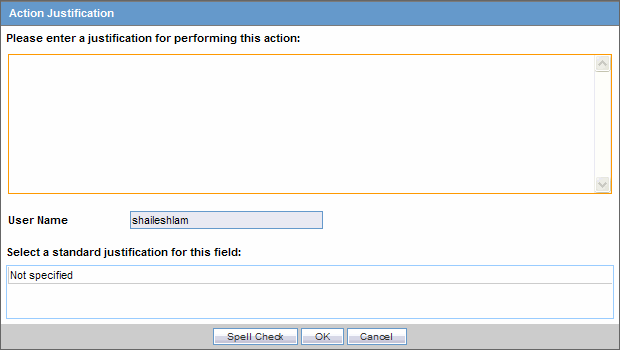
In the Reject Local Event dialog, click OK.
When the case is rejected, the Reject icon appears adjacent to the case.
When the case is rejected, the action item is displayed within LAM Worklist - LAM Action Items from Central in both Initial and Follow-up rejection scenarios, with the following attributes:
| Initial Events | Follow-up |
|---|---|
| Date | The local date of the person rejecting the case |
| Action Item Code | The action item code that can be configured through List Maintenance. |
| Action Item Description | "Case rejected by central due to" followed by the notes/reason entered by the Argus Affiliate acceptor. |
| Responsible User | Set to "any". |
| Due Date | The due date, which is populate automatically. |
After a case related to the local event is created in Argus Safety, the events for the case must be encoded.
Refer to Argus Safety Web User's Guide for information on encoding events.
After the events for a case are encoded, the case can be locked so that local labeling can be performed by the Affiliate Users.
Refer to the Argus Safety Web User's Guide for instructions on locking a case.
When you review incoming events, you can update a case with the follow-up information routed by the local affiliate.
To enter follow-up information:
Click the icon associated with the incoming event and select Accept Follow-up.
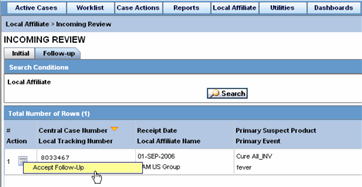
The follow-up information appears in a new window in PDF format.

Review the follow-up information in the follow-up report. You can then make the appropriate changes to the case information from the Argus Safety Case Form.
Note:
The follow-up information appears in the Additional Info tab of the Case FormRefer to the Argus Safety User's Guide for further information on entering case information on the Case Form.
You can accept follow-up for an archived case. Use the following procedure to do so.
To accept a follow-up for an archived case:
Enter the password and required notes, to reopen the case from the Archived Case dialog.
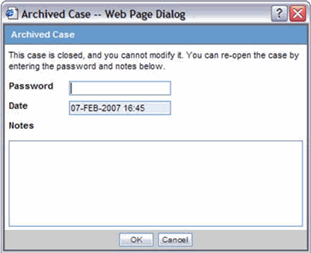
If you are able to unarchive the case successfully, the standard routing dialog is displayed.
The system auto-populates the "Current State" field with the state it was archived from (such as Work in Progress).
The system auto-populates other values in the Routing dialog based on the current state following the normal or current functionality of the Routing dialog.
You can accept follow-up for locked case. Use the following procedure to do so.
To accept a follow-up for a locked case:
Enter the password and required notes, to unlock the case from the Locked Case dialog.
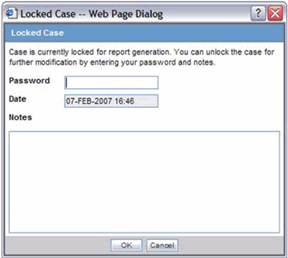
If the case is unlocked successfully, the system opens the standard routing dialog. The Current field is auto-populated in this dialog with the state it was currently in.
The other values in this dialog can also be auto-populated based on the current state.
The preceding functionality of the Current State is the same for accepting follow-ups for open cases. In all scenarios, the last follow-up date entered in Argus Affiliate is auto-populated in the Argus accepted case.
An Argus Affiliate Follow-up case is identified by a red exclamation mark in the Worklist > New section of Argus Safety.
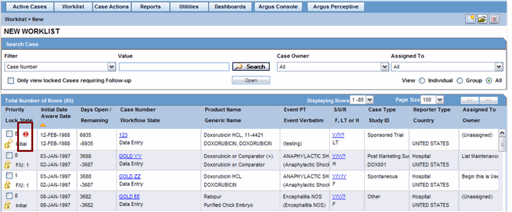
This icon is cleared automatically after the case is routed.
Use the following procedure to view affiliate report submissions.
Select Report Submission from the Local Affiliate menu to open the Report Submission page.
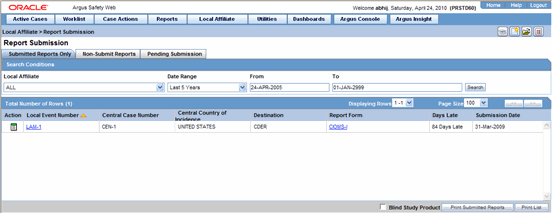
Select whether you want to view Submitted Reports only or Non-Submit Reports or reports that are Pending Submission.
Enter a custom date range or select an appropriate date range under Range.
Click Search. A list of submitted or non-submitted reports appears as per the option you selected.
To view report details, click the icon associated with the report and select Report Details.
To open a report, click the icon associated with the report and select View Report.
The Report Submission page has three tabs as follows:
The following is an illustration of the Submitted Reports Only tab.

The following table lists and describes the fields on the Submitted Reports Only tab
| Field | Description |
|---|---|
| Local Affiliate | Enables you to select the local affiliate to be viewed. |
| Date Range | Enables you to specify a date range for searching report during a period.
Note: If a Date Range is selected, the From and To fields get populated automatically. |
| From | Enables you to manually enter the start date for the search period. |
| To | Enables you to manually enter the last date for a search period. |
| Action | View Report |
| Report Details | Enables you with the option of viewing report details. |
| Unsubmit Report | Enables you to un-submit the selected reports. |
| Local Event Number | Displays the Local Event Number of submitted reports. Click this link to view the report in a PDF. |
| Central Case Number | Displays the Central Case Number of submitted reports. |
| Central Country of Incidence | Enter the country where the adverse event occurred. Enter the partial two-character code, the country name, or the three-character code. Argus Safety will decode the entry. The Administrator can adjust the information in this list. |
| Destination | Displays the destination of submitted reports. |
| Report Form | Displays the type of report form for the report. Click this link to view the report in a PDF. |
| Days Late | Displays the days by which the report had been delayed in its submission. |
| Submission Date | Displays the date when the report was submitted. |
| Blind Study Product | Enables you to blind the study product on the Submitted Expedited reports. |
| Print Submitted Reports | Enables you to print the submitted reports. |
The following is an illustration of the Non-Submit Reports tab.

The following table lists and describes the fields on the Non-Submit Reports tab.
| Field | Description |
|---|---|
| Local Affiliate | Enables you to select the local affiliate to be viewed. |
| Date Range | Enables you to specify a date range for searching report during a period.
Note: If a Date Range is selected, the From and To fields get populated automatically. |
| From | Enables you to manually enter the start date for the search period. |
| To | Enables you to manually enter the last date for a search period. |
| Action | View Report |
| Report Details | Enables you with the option of viewing report details. |
| Local Event Number | Displays the Local Event Number of unsubmitted reports. Click this link to view the report in a PDF. |
| Central Case Number | Displays the Central Case Number of unsubmitted reports. |
| Central Country of Incidence | Enter the country where the adverse event occurred. Enter the partial two-character code, the country name, or the three-character code. Argus Safety will decode the entry. The Administrator can adjust the information in this list. |
| Destination | Displays the destination of unsubmitted reports. |
| Report Form | Displays the type of report form for the report. Click this link to view the report in a PDF. |
| Days Late | Displays the days by which the report had been delayed in its non-submission. |
| Non-Submission Date | Displays the date when the report was not submitted. |
The following is an illustration of the Pending Submission tab.

The following table lists and describes the fields on the Pending Submission tab.
| Field | Description |
|---|---|
| Local Affiliate | Enables you to select the local affiliate to be viewed. |
| Date Range | Enables you to specify a date range for searching report during a period.
Note: If a Date Range is selected, the From and To fields get populated automatically. |
| From | Enables you to manually enter the start date for the search period. |
| To | Enables you to manually enter the last date for a search period. |
| Action | View Report |
| View Draft Report | Enables you to view the draft report. |
| Report Details | Enables you with the option of viewing report details. |
| Local Event Number | Displays the Local Event Number of unsubmitted reports. Click this link to view the report in a PDF. |
| Central Case Number | Displays the Central Case Number of unsubmitted reports. |
| Central Country of Incidence | Enter the country where the adverse event occurred. Enter the partial two-character code, the country name, or the three-character code. Argus Safety will decode the entry. The Administrator can adjust the information in this list. |
| Destination | Displays the destination of unsubmitted reports. |
| Report Form | Displays the type of report form for the report. Click this link to view the report in a PDF. |
| Days Late | Displays the days by which the report had been delayed in its non-submission. |
| Submission Date | Displays the date when the report was due for submission. |